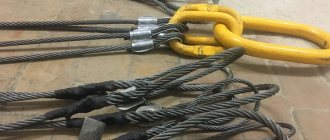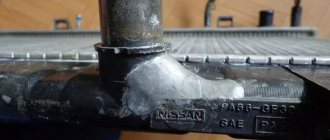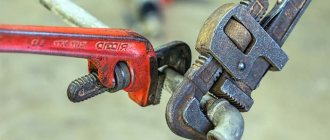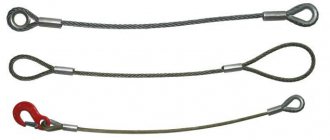Slings are a device for lifting and moving loads.
It may be based on a rope, chain or cable. The device must securely secure the cargo that needs to be transported, while ensuring safety for workers and the safety of the goods. Lifting slings, regardless of the area in which they are used, must be in accordance with state standards. Certification of this type of product is mandatory.
Slings are used in construction, industrial sectors, and agriculture. According to the material, they can be rope, chain and textile.
Rope slings
Rope slings can withstand both very low (-40 degrees) and very high temperatures (400 degrees).
The rope is made from wire woven into strands. This design makes it possible to detect abrasion early and thus prevent sudden rupture of the lifting device.
The price of a sling depends on its type, length and load capacity.
For example, a single-branch rope sling 1 meter long and with a carrying capacity of 32 kilograms costs 111 rubles. A ten-meter sling holding 10 tons costs 5,350 rubles. The more branches, the more expensive the sling.
Models
There are two ways to produce rope slings:
- crimping with an aluminum bushing (filling);
- hand weaving (braiding);
- Single branch sling (1 SC). Consists of one rope branch.
- Two-legged sling (2 SK). Widely used in industrial enterprises and warehouses.
- Four-legged sling (4 SK). The design has a link and 4 rope branches. Often used in construction, warehouses and factories.
- Rope branch (VK). The ends of the branches are sealed either with braiding or crimping.
- Ring sling (SKS). The hook is in contact with the load.
- Loop sling (Loop sling). Like the ring one, it ensures contact of the hook with the load. One of the most common types of rope slings.
Classification by strength classes
The load-carrying capacity of the device depends on the strength of its individual parts. According to strength classes, chain slings are usually divided into several types:
- 3rd class – load capacity up to 100 kg.
- 5th class – load up to 300 kg;
- 8th class - load capacity should not exceed 800 kg;
- 10th class – you can lift loads up to 1.2 tons;
- 12th class – designed for transporting cargo up to 3.1 tons.
When choosing a strength class, it should be taken into account that the given parameters are valid for operation at temperatures up to 200 degrees.
Chain slings
A chain sling is a chain of steel links connected to each other by welding.
Very durable design, flexible and comfortable. Withstands loads with sharp edges. Such slings are easy to repair. They are not damaged by acids, open fire, or low temperatures. Compared to rope slings, chain slings weigh more.
The cost of a single-leg chain sling with a lifting capacity of 1 ton is about 1,000 rubles, 8 tons is approximately 5,000 rubles.
Models
- Single-leg sling (1SC). Can be used at extremely low or high temperatures.
- Two-legged sling (2SC). Due to two branches, it has greater lifting capabilities than 1SC. If the load is critical, the chain links will stretch but not break. Used in rigging and construction. The sling is hung on the crane hook. You can adjust the length of the branches.
- Four-leg sling (4 SC). This sling is also called a chain spider. Consists of a link and four branches of chains. Used for lifting and transporting cargo of non-standard shape.
- Chain branch (CCB). It usually serves as a spare part for repairing a chain sling, but can also be used independently to connect cargo and lifting equipment.
- Ring sling (RSS). Otherwise called universal. The chain in this case looks like a ring. Used for lifting and transporting loads in extreme temperature conditions. Suitable for moving loads with sharp contours.
Marking
The tag attached to the sling must contain the following information:
- type of sling (number of branches and their material);
- lifting capacity in tons;
- sling length in millimeters;
- serial number;
- date of testing of the device at the factory;
- name of the manufacturer;
Advantages:
- flexibility and mobility - this allows the use of various slinging options;
- work is allowed at temperatures from -40? (but without shock loads) up to +200? (with restrictions on maximum weight - up to +500?), as well as in aggressive liquids and open fire;
- long service life due to maintainability - damaged links can be replaced;
- the greatest safety compared to other types of slings - the deformation of individual links is immediately noticeable;
- The use of limit hooks at the top of the sling allows you to shorten the length of the chain if necessary.
Textile slings
They differ from other types of slings in their greater versatility.
Polyester tape is used as the material for textile slings. Such lifting devices do not damage the load when moving it. The color of the sling depends on the load its design can withstand.
The slings are protected by a special fabric, which extends their service life. It is not particularly difficult to carry them under a load and attach them to a crane hook. They do not deteriorate from contact with oil, water, or acids.
They can be used in any climatic conditions. They do not lose their properties even with a sharp temperature change.
A textile sling 30 millimeters wide, 1 meter long and with a carrying capacity of 1 ton costs 140 rubles. A nine-meter one with the same carrying capacity costs 730 rubles.
Models
- Tape slings. They are needed to lift and move various loads that require careful handling - a soft grip. The coating, shape, and structure of the product are not affected.
- Circular slings. They are made from very durable polyester ring fiber. With the help of such slings, large loads (up to one hundred tons), but requiring delicate handling, are lifted and transported.
Marking
- STK - textile ring slings, made of one or several layers.
- STP - textile loop slings, made of one or several layers.
The tag indicates the lifting capacity of the sling (0.5...50 tons), its type, length, type of loop (ring).
There may be such marking: 1ST. This means that there is one branch in the textile sling.
Identification marking
So how can you make sure you're using the right sling for the job? Each product has a tag or other identifying marking that identifies, at a minimum, the synthetic material and load rating, as well as the manufacturer's name, trademark, or logo. Moreover, the color of the tag corresponds to a specific material:
- BLUE: polyester (PES)
- GREEN: polyamide (PA)
- BROWN: polypropylene (PP)
If any part of the tag is missing or illegible, the equipment is not fit for use and must be taken out of service.
Determining the load capacity of textile slings by color
The color coding system is part of numerous regulations in the field of lifting work using textile lifting devices. The regulations require that different color codes be used to visually identify the safe working load limit of textile slings.
| Color | Maximum load, t |
| Violet | 1 |
| Green | 2 |
| Yellow | 3 |
| Grey | 4 |
| Red | 5 |
| Brown | 6 |
| Blue | 8 |
| Orange | more than 10 |
Textile sling options
Requirements for the design, materials and safety of general-purpose cargo slings made of textile tape are defined in the RD and TU documents, which were developed by specialists from manufacturing companies.
Explanation of some designations of textile slings:
- STK
– ring - STP
– single loop with soft loops - 1ST
,
2ST
,
3ST
,
4ST
– one-, two-, three- and four-legged with hooks and ring
The letter “K” is added to circular products:
- STKK
– circular circular strand - STPK
– single loop round strand
Types of slings and designation
The most popular and universal are ring (STK) and loop (STP) slings. The ring configuration is designed for tying loads (not hooking) and allows the user to rotate the hook and load contact points, which increases the durability of the straps.
Loops are often called "rag chucks" and have the ends (loops) wrapped with extra material to prevent rapid wear and tear at the contact points.
Load-handling devices 1ST, 2ST, 3ST, 4ST allow you to organize the lifting of cargo using one, two, three or four lifting gripping points. Their branches are united by an upper power ring for hanging on a crane hook and can have various designs of metal end elements (hooks, rings, brackets).
Ring sling STK
Traverses
Traverses are special removable devices for grasping cargo.
It secures goods during loading and unloading and can be used for lifting long loads or where height is limited. Crossbars are manufactured according to drawings, depending on the task they will have to perform. They make mounting traverses, magnetic and lifting.
Lifting beams lift the crane beams and the braking system. The gripper is secured with a pin to the beam under the crane. When the crane beam is installed in the design position, the pin is removed. The crossbars are attached with hooks to a special platform.
Magnetic traverses do not require external energy to hold the load. The magnetic field created by the devices does not interfere with the operation of neighboring mechanisms. The length of the traverse is changed using 2 cylinders. A load length of 12 meters is possible.
How does the sling angle affect the lifting capacity?
When slings are used at an angle during lifting, their lifting capacity is reduced because additional tension is created on the branches. As the angle between the slings increases, the breaking force on each leg increases. Acceptable angles are up to 90° and no more than 120°.
For example, if the angle α is 90°, then each leg of the sling experiences a load equal to 71% of the weight of the load. And with α equal to 120°, each leg already has a force equal to the weight of the load. In any case, the slinger must take into account the angular stress of the branches and use reduction factors for the lifting capacity.
When lifting directly (vertical position of the coupling device), the coefficient is 1, which means you can use the full lifting capacity of the sling.
When slinging “with a noose”, the coefficient is 0.8, that is, the load capacity of the chuck is reduced by 20%.
With the “basket” slinging method, if the branches are located vertically at an angle of 90° to the horizontal, a factor of 2 is applied, and the lifting capacity of the sling is doubled.
Grips
To simplify the work of slinging loads, the slings are equipped with links that act as grippers.
Grips can be different in operating principle, design and size. They are often used to organize the production of mass goods - where it is necessary to transport a lot of similar cargo.
The grips are made of alloy and low-alloy steel, and due to this, the devices are small and light.
Types of grips
- Kleshchevoy. Resembles scissors, the ends of which grip a load or part of a load.
- Eccentric. The load is held by eccentrics. Typically used for transporting flat loads.
- Clamping. Clamps the load, holding it.
- Fork. The gripper is under load.
- Koromyslovy. The working body of such a grip is similar to a rocker arm. It is used to work with loads that have holes.
- Klinova. The working element of the gripper jams in the hole of the transported load.
- Shtyrevoy. The pin is secured in the hole of the load being moved.
- Magnetic. With the help of such grips, ferromagnetic loads are lifted, moved and held. The load is held by high-power magnets. They can be used for 15 years. This type of grip is convenient to use, since there is no need to use slings. The magnet touches the load with its working surface, a special lever turns on the magnetic field. If you return the lever to its original position, the field is turned off.
Norms and rules for rejecting slings
According to the requirements of safety rules, slingers must inspect slings immediately before their use, and persons responsible for the maintenance of lifting machines and the safe performance of work with lifting machines must inspect slings (with the exception of rarely used ones) - every 10 days, and rarely used removable lifting devices before issuing them to work.
When inspecting slings, it is necessary to pay attention to the condition of the tapes, chains, cables, end elements, pendants, carabiners and places of their fastenings and promptly reject slings with unacceptable defects
Rejection of textile slings:
— there is no mark (tag) or information about the sling is not readable; — knots on the load-bearing tapes of slings; — transverse cuts or tears of the tape; — longitudinal cuts or tears in the tape, the total length of which exceeds 10% of the total length of the sling tape or single tears no more than 50 mm long; - local delamination of the sling tapes, except for places where the edges of the tapes are sealed, at a length of more than 0.5 m on one outer seam or two or more internal seams (when three or more seam lines are torn); - local delamination of sling tapes in the place where the edges of the tape are sealed for a length of more than 0.2 m on one of the outer or two or more internal seams (when three or more seam lines are broken), as well as peeling of the edge of the tape or stitching of tapes at a loop for a length of more than 10% of the length of the ends of the tapes; — surface breaks of belt threads with a total length of more than 10% of the belt width, caused by the mechanical impact of the sharp edges of the load; — damage to belts from exposure to chemicals (acid, alkali, solvents, petroleum products, etc.) with a total length of more than 10% of the width and length of the sling or individual damage of more than 10% of the width and length of more than 50 mm; — bulging of threads from the sling tape at a distance of more than 10% of the tape width, including through holes with a diameter of more than 10% of the tape width from the impact of sharp objects; — burnt through holes with a diameter of more than 10% of the width of the sling strip from exposure to splashes of molten metal or the presence of more than three holes with a distance between them of less than 10% of the strip width, regardless of the diameter of the holes; — contamination of belts with petroleum products, resins, paints, cement, soil, etc. more than 50% of the sling length; — delamination of threads of sling tapes.
Rejection of rope slings:
— the tag or passport for the sling is missing (or damaged); — knots, twisting, kinks and creases in ropes; — if the number of visible breaks in the outer wires of the rope exceeds (for slings made of double lay rope) 3d – 4, 6d – 6, 30d – 16; — reduction in rope diameter due to wear or corrosion by 7% or more; — reduction in the diameter of the outer wires due to wear or corrosion by 40% or more; — reduction in rope diameter by 10% due to damage to the core; - breakage of at least one strand; — extrusion of the core; — damage due to temperature or electrical arcing; — deformation of the thimble or wear of its cross-section by more than 15%; — cracks on the crimp bushing or changes in its size by more than 10% of the original; — there are no safety locks on hooks or other gripping elements; — if the marking tag is missing or damaged; - with damaged or missing braids or other protective elements in the presence of protruding ends of the wire at the braiding point; - with hooks that do not have safety locks.
Rejection of chain slings:
— the tag or passport for the sling is missing (or damaged); — the markings on the sling elements are missing or unreadable; — the difference in the lengths of the sling branches, with its free sagging of more than 15 mm; — when lengthening a chain link, hinged links and pendants by more than 5% of the original size; - when the cross-sectional diameter of chain links and suspended links due to wear decreases by more than 8%; — there are no safety locks on hooks or other gripping elements.











